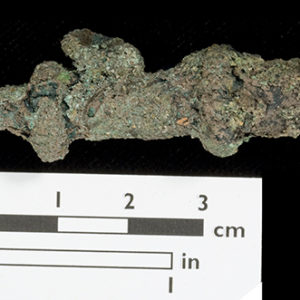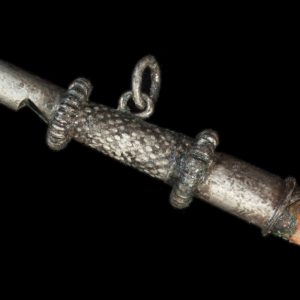Bly Straube, senior archaeological curator for the Jamestown Rediscovery project, is preparing a combination whistle and teething stick for exhibit this spring. She says the object is a reminder of one of the early Jamestown lives lost to history. “Children lacked legal status and power, but they were in James Fort. Now we have the documented presence of a young child,” Straube said.
Thousands of people reached Jamestown in the early 17th century, but children usually escaped notice unless they were linked to events in court records, Straube said. The first children in the colony–four cabin boys and pages to gentlemen–arrived in 1607. No one noted their ages, but they were probably at least 14, the customary age for apprenticeships in London.
Younger children most likely accompanied 30 or 40 women aboard the ships of the colony’s third supply that left England in June 1609. The fleet ran into a massive hurricane just before the ships reached Virginia. One of the ships, the Blessing, made it to Jamestown in August 1609 with a group that included 20 women and children. Another ship, the Sea Venture, shipwrecked in Bermuda with at least five, and possibly 10, women. Two babies were born during the nine months the castaways were on the islands. One survived and may have arrived at Jamestown with the rest of the Bermuda group in May 1610.
A whistle for teething would be used by a very young child. Teething typically occurs between six months and two years of age–and was historically thought to be a cause of illness and death, Straube said. “Among the many Diseases that do threaten for the life of Infants, there is none that produceth so many grievous Symptoms as their laborious and difficult breeding of Teeth,” wrote Walter Harris, physician to King William and Queen Mary, in 1694.
Teething certainly would have been difficult in the harsh environment of Jamestown’s early years. The pain of teething and the associated process of weaning (with its dietary changes) may have added stress to an already weakened child, contributing to its death. In the 17th century, more than 12 percent of children died within the first year of life, Straube said.
“It was a very vulnerable time. So this object, it’s a talisman,” Straube said. “These teething objects were apparently special gifts to children at the time of their christening. It was not the type of thing a poor child would have had.”
The teething device has a tube of decorated sheet silver, two rings of spiraled silver wire that would jingle when shaken, and fastened to the whistle for good luck is a piece of red coral from the shallow coastal waters of the Mediterranean.
The whistle’s piece of coral was important, Straube said. Since Roman times people believed coral to have magical properties. The 16th-century physician Paracelsus confirmed the power of coral, and well into the 19th century the smooth, hard substance was considered a comfort for teething children.
This whistle teething stick was found in the trash that filled a circa 1608-10 well in the center of James Fort. Connected to a storehouse was a large rectangular cellar with a barrel-lined well in the floor. The well went down 14 feet and was abandoned and backfilled with rubbish sometime before 1611.
This teething stick was recovered during water screening of the well’s soil through one-eighth inch mesh. It was heavily encrusted and appeared green from the silver-copper alloy of the metal, Straube said. Conservators carefully removed this corrosion using a scalpel and weak acids under a microscope. Only a fragment of red coral is still held in the opening of the silver whistle, but small pieces of coral have been found in other layers of the well, which probably relate to this object, she said.
The Jamestown Rediscovery staff had wondered about the copper content of the stick since finding it so corroded in 2009. In the summer of 2011, Dr. Marcos Martinon-Torres visited Historic Jamestowne and used a portable X-ray florescence spectrometer to confirm the child’s whistle teething stick is good silver–94 percent silver, just a bit below the silver content of a coin of the era.
Straube said this kind of spectrometer–a technological advance of the past 10 years–is a great help because it looks at chemical composition without requiring an artifact be broken apart.
related images
- Teething stick before conservation
- Silver and coral teething whistle after conservation







